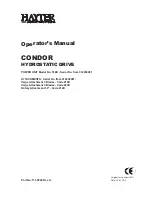
14
Briggs & Stratton Power Products Home Generator System
Owners Manual
DON'T OVERLOAD YOUR
GENERATOR
NOTE: Refer to this section when you are using the
generator without the semi-automatic transfer switch. Ask
your semi-automatic transfer switch installer to review load
management techniques. See “Essential Circuits” on page 6.
Capacity
You must make sure your generator can supply enough
rated (running) and surge (starting) watts for the items you
will power at the same time. Follow these simple steps:
1.
Select the items you will power at the same time.
2.
Total the rated (running) watts of these items.This is
the amount of power your generator must produce to
keep your items running. See Figure 14.
3.
Estimate how many surge (starting) watts you will
need. Surge wattage is the short burst of power
needed to start electric motor-driven tools or
appliances such as a circular saw or refrigerator.
Because not all motors start at the same time, total
surge watts can be estimated by adding only the
item(s) with the highest additional surge watts to the
total rated watts from step 2.
Example:
Total Rated (Running) Watts
= 3075
Highest Additional Surge Watts
= 1800
Total Generator Output Required = 4875
Power Management
To prolong the life of your generator and attached devices,
it is important to take care when adding electrical loads to
your generator.There should be nothing connected to the
generator outlets before starting it's engine.The correct
and safe way to manage generator power is to sequentially
add loads as follows:
1.
With nothing connected to the generator, start the
engine as described in this manual.
2.
Plug in and turn on the first load, preferably the largest
load you have.
3.
Permit the generator output to stabilize (engine runs
smoothly and attached device operates properly.
4.
Plug in and turn on the next load.
5.
Again, permit the generator to stabilize.
6.
Repeat steps 4 and 5 for each additional load.
Never add more loads than the generator capacity.Take
special care to consider surge loads in generator capacity,
as described above.
*Wattages listed are approximate only. Check tool or
appliance for actual wattage.
Tool or Appliance
Rated (Running)
Watts
Additional Surge
(Starting) Watts
Window Air
Conditioner
1200
1800
Refrigerator
800
1600
Deep Freezer
500
500
Television
500
-
Light (75 Watts)
75
-
3075 Total
Running Watts
1800 Highest
Surge Watts
Tool or Appliance
Rated*
(Running)
Watts
Additional
Surge
(Starting)
Watts
Essentials
Light Bulb - 75 watt
75
-
Deep Freezer
500
500
Sump Pump
800
1200
Refrigerator/Freezer - 18 Cu. Ft.
800
1600
Water Well Pump - 1/3 HP
1000
2000
Heating/Cooling
Window AC - 10,000 BTU
1200
1800
Window Fan
300
600
Furnace Fan Blower - 1/2 HP
800
1300
Kitchen
Microwave Oven - 1000 Watt
1000
-
Coffee Maker
1500
-
Electric Stove - Single Element
1500
-
Hot Plate
2500
-
Family Room
DVD/CD Player
100
-
VCR
100
-
Stereo Receiver
450
-
Color Television - 27”
500
-
Personal Computer w/17” monitor
800
-
Other
Security System
180
-
AM/FM Clock Radio
300
-
Garage Door Opener - 1/2 HP
480
520
Electric Water Heater - 40 Gallon
4000
-
DIY/Job Site
Quartz Halogen Work Light
1000
-
Airless Sprayer - 1/3 HP
600
1200
Reciprocating Saw
960
960
Electric Drill - 1/2 HP
1000
1000
Circular Saw - 7 1/4”
1500
1500
Miter Saw - 10”
1800
1800
Table Planer - 6”
1800
1800
Table Saw/Radial Arm Saw - 10”
2000
2000
Air Compressor - 1-1/2 HP
2500
2500
Figure 14 - Wattage Reference Chart






































